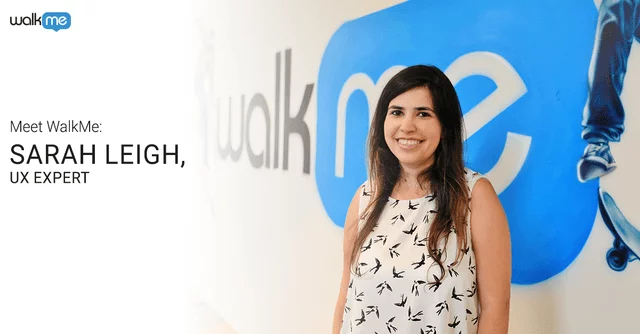UX is the name of the game at WalkMe.
Our entire business model is aimed at improving the user experience on any website or web- based software. In simple terms, we are there to navigate users through any process with ease. Think of us as your virtual assistant leading you down the digital yellow brick road.
Given our mission statement, the talented UX designers we employ are especially dedicated to making WalkMe effortless.
Let us introduce you to Sarah Leigh, UX expert at WalkMe. Sarah shared her insights into the WalkMe platform, how she and her team keep users happy and satisfied, and how she develops her own UX knowledge.
Easily perfect your UX using WalkMe’s onscreen guidance. Try it today.
Tell us a bit about yourself and your role at WalkMe.
Sarah Leigh: I’m a UX expert at WalkMe. I’ve always been inspired to create great products, but I truly discovered UX four years ago when I started out at the company and have been hooked ever since.
Speaking of being hooked, what professional resources do you keep at hand at all times? Favorite blogs/websites/magazines?
Sarah Leigh: My favorite website is Medium. Many accomplished companies and people use the platform to blog about their user experience goals and expertise. On Medium, I follow the design blogs of Salesforce, Atlassian and Google. I’m also a fan of Julie Zhuo’s blog, The Year of the Looking Glass.
What’s been keeping you busy in the last month?
Sarah Leigh Katz: Well, there is something that has been keeping myself and the team busy, but I have to keep it under wraps for now… But I can tell you it has to do with an update to the next generation of the WalkMe product – improving the UX and features for our users. Can’t wait for you to see once it goes live!
A great product relies on feedback from customers to ensure it’s constantly meeting customer needs. How do you go about collecting feedback and analyzing that feedback to improve the usability of the WalkMe platform?
Sarah Leigh: Absolutely, feedback is probably the most important aspect of creating great UX. We talk to our customers often to ask them about their experiences, in addition to performing usability testing for all our new features.
Another way we improve usability is by monitoring end-user analytics for each of our customers to make sure their own users are engaged.
“Feedback is probably the most important aspect of creating great UX”
Can you give us some insight on how WalkMe helped solve a specific problem for one of our customers?
I do know of one of one of our success stories, Truckstop.com. They were looking for a simple solution to improve their platform’s usability – one that could be easily applied across all of its products and solutions. Customers were having difficulty onboarding and engaging with the platform, which put them at a high risk for churn. Truckstop.com was also experiencing large (and costly) daily volumes of support requests, primarily through their phone system. What they did was implement WalkMe as an additional layer on top of their site. Our software guided customers step-by-step on how to upgrade their account for example. As a result they watched as support requests dropped by double digits.
Allow WalkMe’s step-by-step guidance to instantly enhance your product’s UX.
Biggest challenge in onboarding new users to the WalkMe platform?
Sarah Leigh: The biggest challenge is making sure users can easily combine the many WalkMe features. We have many different applications (smart tips, shuttles, and chat ) that clients can utilize together to engage their users in the best way possible. Many times using more than one feature delivers the most value. As we move forward, the product is becoming more and more geared toward this concept.
What’s the most common UX pitfall you recognize in internal systems?
Sarah Leigh: Internal systems tend to expect users to complete tasks that don’t have logical user flows. Entities are represented separately in the system with no apparent connection between them, although in the real world they go hand in hand with the task the user wants to perform.
“Direct, concise flows create the most beneficial UX, otherwise it is too much for users to digest.”
Specifically, when using WalkMe to create user flows on internal systems, many users assume they should use the tool to explain every mundane aspect of the system. They create very detailed flows for their employees instead of focusing on the crucial details.
One of WalkMe’s strongest points is its ability to provide contextual information for users. Direct, concise flows create the most beneficial UX, otherwise it is too much for users to digest. At the end of the day, that’s the most important thing to remember – the user journey.
Thousands of companies love our product because it makes their employees’ lives easier when it comes to continuous training, onboarding, self-service and everything in between. And their clients love the additional layer of support they receive when engaging with the company’s online services. In essence, we are the UX glue for your customers to stay put.

